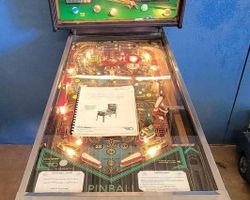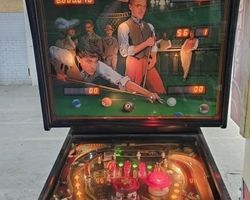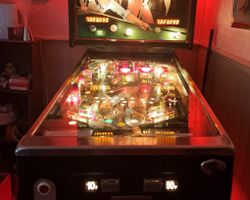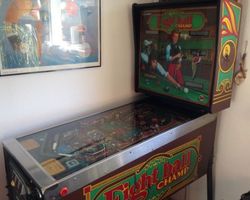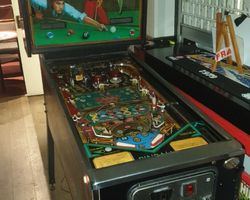Eight Ball Champ
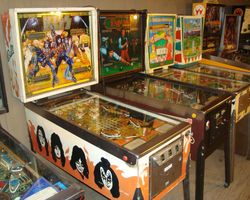
Average Prices: USD $200 to $1,500
Produced: August, 1985
Production Run: 1,500 units
Machine Type: Solid State Electronic
MPU: Bally MPU A084-91786-AH06 (6803)
Players: 4
Design by: George Christian
Art by: Tony Ramunni
Bally Manufacturing Co. introduced Eight Ball Champ to arcades and homes in August 1985, marking a distinct entry in the solid-state pinball era. This machine holds a unique position, being the third and final installment in Bally's informal "Eight Ball" trilogy, following its popular predecessors. The thematic inspiration, consistent with its lineage, delves into the world of pool and billiards, translating the strategic nuances of the cue sport into pinball mechanics.
The design and production of Eight Ball Champ involved a focused team. George Christian was responsible for the game's overall design, meticulously crafting the playfield layout and gameplay flow. The visual identity of the machine, from the backglass to the playfield, was brought to life by artist Tony Ramunni. Rehman Merchant handled the software development, imbuing the machine with its specific rules and scoring algorithms. With a confirmed production run of 1,500 units, Eight Ball Champ was a relatively limited release for its time, contrasting with the higher production numbers of some of its contemporaries. A notable technical milestone for Bally with this machine was its pioneering use of the 6803 control board for its entire production run, a significant step in the evolution of their pinball hardware. It also featured Bally's AS-2518-81 "Squawk and Talk" sound board, integrating custom speech into the gameplay experience.
Signature Features and Design
Eight Ball Champ distinguishes itself with several characteristic elements that contribute to its unique appeal, despite its mid-1980s release date, it possesses an aesthetic that some describe as carrying a 1970s design sensibility. A prominent visual aspect is the sheer number of lamps illuminating the playfield, which creates an inviting and dynamic presentation. This abundance of lighting not only enhances visibility but also serves to beckon players and highlight active shots.
The auditory experience is heavily influenced by the "Squawk and Talk" sound board, a feature that provides custom speech call-outs throughout the game. While this technology was a forward-thinking inclusion for its time, integrating voice into gameplay, its reception among players was varied. Some appreciated the vocal cues for adding an immersive layer, while others found the repetitive nature of the speech, and the occasional recycling of voice clips from earlier Bally titles, could become tiresome over extended play.
From a practical design perspective, the machine incorporated a hinged backglass and backboard assembly. This thoughtful engineering choice significantly streamlines maintenance and serviceability, allowing technicians and owners easier access to the internal components. The artwork package itself presents a study in contrast. While the playfield art, also by Tony Ramunni, is generally regarded as appropriate for the pool theme, displaying a classy and functional aesthetic that works well with the playfield lamps, the backglass art is a point of frequent discussion. Often depicted as a turn-of-the-century bar scene, its visual style elicited strong, often critical, opinions from players who felt it did not align with the game’s energy or overall theme. The cabinet art, primarily applied through decals, is functional and theme-fitting, though some units exhibited issues with peeling over time, a common wear characteristic for machines of this vintage.
Playfield and Mechanics
The playfield of Eight Ball Champ is a meticulously arranged layout designed to emulate the strategic nature of a pool table, emphasizing precise shot execution. It features an open design with a deliberate spread of targets and mechanisms, encouraging players to aim for specific objectives across the entire surface.
Central to the gameplay are the five drop targets, strategically placed to represent a rack of pool balls. These targets demand accurate shots to register, often requiring players to hit them in sequence to advance game objectives. Complementing these are two pop bumpers positioned for chaotic ball redirection, and two slingshots that provide reactive bounces, adding an element of unpredictability to the ball's trajectory. Three star rollovers further contribute to scoring and bonus progression.
A crucial interactive element is the kick-out hole, often serving as a collection point for successful shots, leading to various scoring opportunities or activating game modes. A spinning target adds a dynamic element, providing a satisfying visual and auditory cue upon impact. The machine is equipped with three flippers: two standard flippers at the bottom of the playfield for primary ball control, and an additional upper flipper. The utility of this upper flipper has been a subject of player discussion, with some finding it less integrated into the game's primary shot architecture compared to its counterparts on other machines.
The flow of Eight Ball Champ is fundamentally a "shooter's game," requiring a high degree of player accuracy. The layout is engineered to foster this precise play, with shots that feel tight and demand careful aiming rather than random flipping. The artwork on the playfield reinforces the billiards theme with a clean, functional design that clearly indicates targets and pathways. This design philosophy, coupled with the numerous playfield lamps, creates a visually appealing and engaging environment that draws players into the game's objectives.
Gameplay Dynamics
Eight Ball Champ delivers a gameplay experience deeply intertwined with its pool theme, centered on precision and strategic shot-making rather than frantic multi-ball action. The core objective often mirrors a game of eight-ball, requiring players to clear specific targets in sequence to advance.
Progression in Eight Ball Champ hinges on disciplined play and understanding the scoring system, where bonus accumulation is paramount. A key strategy involves spelling out C-H-A-M-P, which can be achieved through specific top lane or inlane rollovers. Successfully completing this sequence awards valuable playfield score multipliers (2x and 3x), significantly boosting points for subsequent shots. The ultimate high score strategy revolves around maximizing these bonus multipliers before hitting the crucial 8-ball saucer, which then converts the accumulated bonus into a substantial score.
The machine is consistently characterized as a challenging "shooter's game." It demands accuracy and skill, with little room for error. The pace of play, especially when configured for a 3-ball game, can be deliberate, which some players prefer for a more controlled and thoughtful pinball experience. Unlike many machines of its era, Eight Ball Champ does not feature a multiball mode, which places even greater emphasis on keeping the single ball in play and making every shot count. There is also no explicit ball save timer, contributing to the game's perceived difficulty and requiring constant vigilance from the player. Players skilled in nudging can find it beneficial, as subtle machine manipulation can be critical for completing certain target sequences, particularly on machines with slight modifications or wear. The game's memorable moments often arise from the satisfaction of executing a series of difficult, precise shots to light the desired features and rack up significant scores.
Reception and Legacy
Eight Ball Champ has garnered a mixed yet generally positive reception within the pinball community, often finding itself in the shadow of its more celebrated predecessor, Eight Ball Deluxe. Players frequently praise it as a challenging "shooter's game" that demands accuracy and offers a rewarding experience when shots are successfully executed. Its unique playfield layout, featuring a good spread of varied shots, and its deep ruleset for its era are often cited as strengths. The effective integration of the pool theme into the gameplay mechanics is also well-received, and the sheer number of lamps on the playfield contributes to a visually engaging experience that some find attractive. The hinged backglass and backboard design, while a functional feature, is also appreciated for its ease of serviceability.
However, the machine faces several common critiques. The "Squawk and Talk" sound system, while innovative for its time, is frequently described as repetitive and can become annoying during extended play. The backglass artwork is a consistent point of contention, widely considered to be out of step with the game's energy and overall aesthetic, with many players expressing a strong dislike for its visual style. Production quality is another area where opinions diverge; some note that the cabinets, often made of particleboard, can be prone to swelling from moisture, and playfield wear, particularly paint loss, is a common issue on older machines. The utility of the upper flipper is also debated, with some players feeling it doesn't offer meaningful shot opportunities. Additionally, the absence of a multiball feature, especially in comparison to other machines from the mid-1980s, is a frequent observation, and some players find the gameplay too slow.
Despite these weaknesses, Eight Ball Champ maintains a particular niche in pinball history. As the final entry in Bally's "Eight Ball" trilogy, it closes a chapter on a prominent theme for the manufacturer. Its status as Bally's first production game to exclusively use the 6803 control board throughout its run marks it as a technical stepping stone. While it may not command the same widespread appeal or market value as some other Bally titles of its era, its dedicated fanbase appreciates its demanding gameplay and the satisfaction derived from mastering its precise shot requirements. It remains a game that, for some, offers a distinct and addictive challenge, ensuring its continued presence in collections and discussions among pinball enthusiasts.
Sponsored Links
 Ebay Listings
Ebay Listings
 Auction Results
Auction Results
| Cost | Location | Date |
|---|---|---|
| USD $3,488 |  Florida, United States Florida, United States |
17 July, 2025 |
| USD $1,700 |  Michigan, United States Michigan, United States |
21 March, 2025 |
| GBP £2,710 |  Bottesford, United Kingdom Bottesford, United Kingdom |
06 February, 2025 |
| USD $1,050 |  Ohio, United States Ohio, United States |
16 November, 2024 |
| USD $2,400 |  Colorado, United States Colorado, United States |
21 August, 2024 |
| USD $1,500 |  Massachusetts, United States Massachusetts, United States |
25 July, 2024 |
| USD $4,500 |  Oregon, United States Oregon, United States |
02 April, 2024 |
| USD $4,500 |  Oregon, United States Oregon, United States |
13 March, 2024 |
| USD $950 |  Illinois, United States Illinois, United States |
23 September, 2023 |
| GBP £2,950 |  Somerton, United Kingdom Somerton, United Kingdom |
02 April, 2023 |


Private Policy · Search Website · Contact Us
As an eBay Partner, we may earn a commission from qualifying purchases made through links on this site, at no additional cost to you.
All trademarks and copyrighted materials remain property of their respective owners. All other content copyright 2007 - 2026 Pinpedia.


